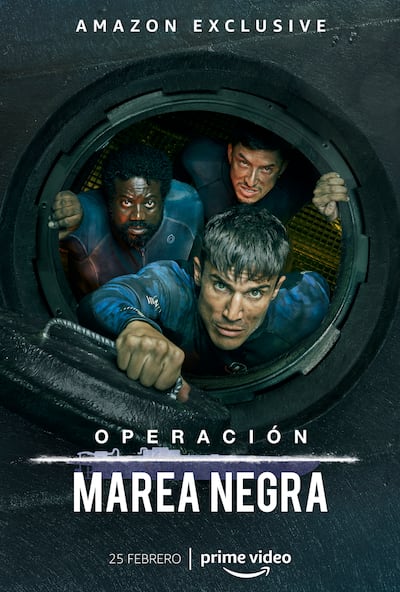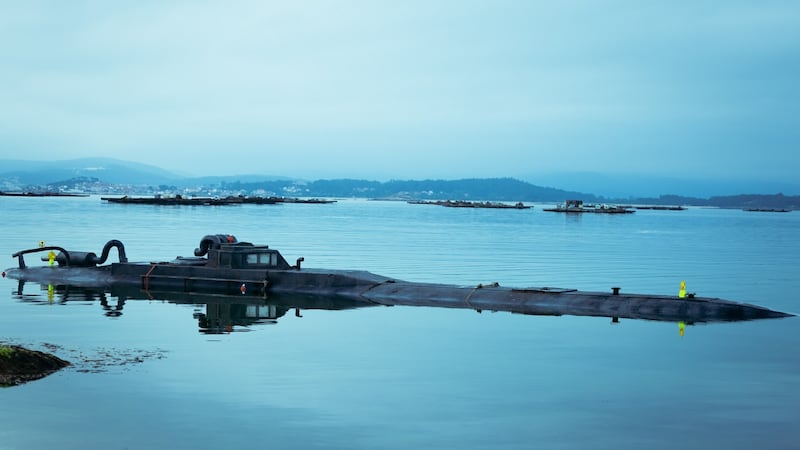Galicia hardly looks like an obvious setting for a hard-hitting crime drama. A rural region of farming, fishing and tourism in the northwest corner of Spain, it is known for its rolling hills, rugged coastline and a strong Celtic influence on its culture.
But three years ago it was also the focal point of a daring criminal endeavour: the transporting of €123 million worth of cocaine 3,500 nautical miles across the Atlantic in a submarine.
That 2019 venture made headlines around the world, after the authorities discovered the 21.5m-long narco-sub, nicknamed "Che". Now, the story of how a young Galician was recruited to navigate the vessel and the subsequent hair-raising voyage has been documented by Galician journalist Javier Romero in a book, Operación Marea Negra (Operation Black Tide), the police code name for the venture. It is also the title of a new four-part Amazon Prime series dramatising the story, which is available to view in Spain, Portugal and Brazil.
Agustín Álvarez, a 29-year-old national amateur boxing champion, was hired to pilot the submarine after the cartel’s first choice dropped out. Romero’s research suggests Álvarez became involved in drug-trafficking by driving shipments of cocaine to Madrid from Spain’s southern coast.

This commission was on a different scale: more than 3 tonnes of Colombian cocaine, to be transported along a section of the Brazilian Amazon, then across the Atlantic to a rendezvous point near Portugal, where it would be picked up by smaller boats and taken ashore. The trip would take two weeks, and Álvarez, who would earn a huge sum, would travel with two Ecuadorean men who would handle the submarine’s maintenance.
“The fact that they navigated along part of the river Amazon and then across the Atlantic in a craft made out of fibreglass, without GPS, using a compass, and with only a basic motor – all of this reminded me a bit of those crossings done in the last century and the 19th century, like Kon-Tiki, which pushed humans to the limit,” says the director of the series, Daniel Calparsoro.
Test of endurance
Being a semi-submersible, 35cm of the top of the vessel remained above the water line, affording the pilot a view of the sea as it travelled at an average of 10 knots per hour (12 mph). But with no toilet facilities and limited space and ventilation, it was a test of endurance for the crew, who were, as Romero writes in his book, “prisoners in something that resembled a tin of sardines”.
The journey was, predictably, a nightmare of claustrophobia, stale air, bad weather and constant danger, with the submarine navigating through three storms and, at one point, nearly crashing into another vessel.
Meanwhile, various logistical problems meant there was no one at the meeting point to relieve them of the cargo. The three men spent another two weeks in the submarine desperately trying to avoid the Spanish and Portuguese police, who by then were closing in with the help of the signals from Álvarez’s increasingly panicked phone calls to his associates.
Che was the first narco-submarine discovered in <a class="search" href='javascript:window.parent.actionEventData({$contentId:"7.1213540", $action:"view", $target:"work"})' polopoly:contentid="7.1213540" polopoly:searchtag="tag_location">Europe</a> known to have crossed the Atlantic
After 27 days at sea, with food and fuel running low, the criminals improvised, sinking the submarine near Álvarez’ hometown of Vigo on the Galician coast and swimming to shore, in the hope of returning to recover the cargo. Police found the submarine, and the two Ecuadorians were arrested soon after reaching land. Álvarez hid out near the coast for several more days before police caught up with him in an abandoned house.
The crossing, Romero says, is “a hell of an achievement”. But he also points out the importance of not romanticising the story. “You have to be critical, because it’s an achievement that is damaging for society and which benefits various criminal organisations,” he says. “It’s important not to forget the final objective of why this narco-submarine was built and why all this craziness was organised.”
Tragic relationship
Galicia’s often tragic relationship with the Atlantic Ocean was recently underlined when a fishing boat from the region sank in Canadian waters, claiming 21 victims, in the latest in a string of such tragedies. Although Operación Marea Negra did not, remarkably, see any casualties, it underlined Galicia’s status as a destination for drugs, particularly from Latin America.
“This was always a land of humble people, but people who worked, who broke their backs working the land and the sea in order to make a living,” says one character in the fast-paced drama. “And one day, suddenly it starts raining money. What do you think happened – that Galicians suddenly turned into brilliant entrepreneurs?”

“In the middle of the 1980s, the tobacco smugglers started to shift to drugs – first hashish and then cocaine,” says Romero, who reports on drug-trafficking for La Voz de Galicia newspaper. He describes his region as “the first port of entry for cocaine to Europe”.
In early February, the three crew members each received 11-year jail sentences. Four friends of Álvarez were also jailed for helping him.
Che was the first narco-submarine discovered in Europe known to have crossed the Atlantic. However, another similar vessel was seized in Málaga last year and more than 150 narco-subs have been captured in Colombia alone over the past decade.
Still, as Operation Marea Negra showed, Colombia is not the only place where they navigate. Spanish investigators, trying to confirm from which country the submarine had been launched, found a pair of new underpants in the vessel that one of the Ecuadorians had left behind. The Brazilian shopping bag the underwear was in became a key piece of evidence in confirming the point of departure.
Operation Black Tide released this month on Amazon Prime in Spain and Latin America




















